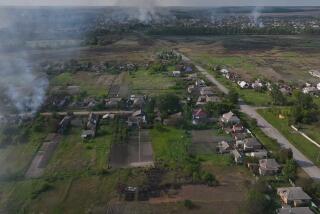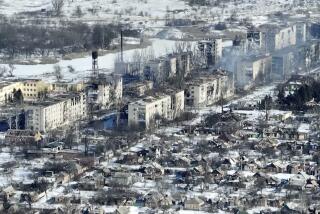Signs of life return to an Afghan ghost town
- Share via
Reporting from Now Zad, Afghanistan — Under a late winter sky, surrounded by mountains left verdant by recent rain showers, is one of Afghanistan’s spookiest-looking and most dangerous places: the once-vibrant but now war-ravaged and virtually empty city of Now Zad.
For decades, it was among Helmand province’s largest and most prosperous cities, thanks at least in part to the profitable opium poppy crop grown by local farmers, many of whom are sharecroppers.
Dozens of shops, numerous schools, government offices and mud-built homes for 25,000-plus residents were arrayed in a crowded pattern that resembled the Western idea of a city. One bakery produced 1,200 loaves of stone-baked bread daily; the main school had 2,500 students.
But residents fled four years ago amid fighting between the Taliban and the U.S.-led coalition. Only howling dogs remained.
The Taliban, seizing the city as a buffer against U.S.-led forces to the south, swooped in and planted hundreds of roadside bombs to block their enemy from using the streets to mount an advance or to set up more than a tiny outpost.
In the middle of last year, 200 Marines assaulted the Taliban in Now Zad and an encampment north of the city, but the result was a stalemate. Then, in December, the Marines launched a new assault, this time with 1,000 troops and several 70-ton assault breacher vehicles to clear a path through the buried bombs.
After several days of fighting, the Taliban dispersed. The Marines and Afghan soldiers and police moved cautiously into Now Zad.
Now there is a campaign to lure the residents back with promises of security, healthcare and schools. A few thousand have returned and Marines and Afghan forces have posted 24-hour guards in a city where nearly all the structures show the ravages of bitter war and harsh winter weather.
“There is no place like Now Zad,” said Michael Ronning, a U.S. foreign service officer and Agency for International Development official, noting that the city’s history makes it unique among the communities where the U.S. is attempting to persuade the population to turn on the Taliban.
The threat of bombs remains high despite the efforts of Afghan contractors, paid by the U.S., to find and dig up the explosives. Large areas remain off-limits, red-tagged as too dangerous while the slow work of de-mining continues, giving the city the look of a ghost town.
Eleven members of a family were killed by an explosion Feb. 28 just a few blocks from their home. That day, U.S. Assistant Secretary of State Andrew J. Shapiro was visiting U.S. troops in Now Zad.
Despite some setbacks, U.S. officials present Now Zad as a story of how a more-aggressive use of military power, backed by a well-organized reconstruction effort, can wrest control of former Taliban strongholds. More VIP visits are expected.
Although Now Zad is nothing like it was before 2006, there are encouraging signs, including a willingness by early returnees to defy the Taliban, officials said.
A health clinic has opened, with a midwife. A school, for boys and girls, is open. Some shops in the main bazaar are selling goods again.
The Taliban is no longer inside the city limits, but fighters can strike on the surrounding roads. Marines based in Twentynine Palms, Calif., provide security in the city and constantly patrol the surrounding foothills.
And five Marines from Camp Pendleton, assigned as part of a “female engagement team,” are hoping to arrange classes and outreach for women. But first they need to convince the women’s husbands of their good intentions. “The men are curious, at least they haven’t said no,” Cpl. Christina Arana said.
In many Helmand province communities, having boys and girls in the same school is unthinkable because it might draw an attack by the Taliban. Nawa, for example, has 11 public schools, but none enroll girls. In Now Zad, the school is open to all, but girls and boys are in separate classrooms.
“I’m not sure what victory looks like, but I think it looks like this,” said Marine Brig. Gen. Larry Nicholson as he looked at a classroom where giggling girls read from spelling books provided by UNICEF.
More to Read
Sign up for Essential California
The most important California stories and recommendations in your inbox every morning.
You may occasionally receive promotional content from the Los Angeles Times.










